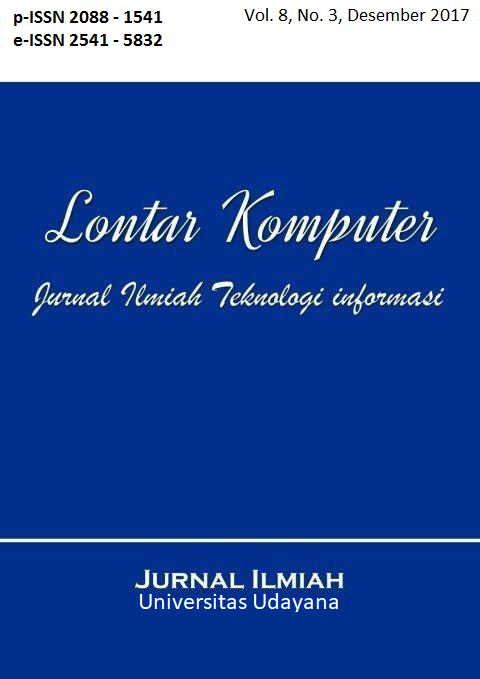Identifikasi Komentar Spam Pada Instagram
Abstract
Spam on Instagram (IG) is generally a comment that is considered as irritating because it does not relate to the photos or videos which were commented. Spam on comment section can cause some negative impacts such as making it difficult to follow the discussion on the posted status and making someone’s photo or video looks very popular, commented by a lot of followers despite the fact that most of the comments are actually spam. This research tries to build a model that can identify spam comments on IG. The comment on IG is in text format, so in this research, we use text processing methods. We use Support Vector Machine (SVM) for spam identification. The comment data used in this study were collected from Indonesian actors and artists who are the most followed accounts in IG. We have tested the spam identification model using SVM method resulted in 78.49% of accuracy. This result is better than the baseline model using NB method (77.25%). This research also tested some of the different training data proportions and SVM remains better than NB. Another result of this research are some adaptations needed for preprocessing and stemming stages that must be customized to support Unicode characters and unique symbols that commonly found in IG comments section.
Downloads
References
2016. [Online]. Available: http://www.musdeoranje.net/2016/08/akun-instagram-dengan-followers-
terbanyak-di-indonesia.html. [Acessed on 9 August 2017].
[2] A. Rachmat and Y. Lukito, “Deteksi Komentar Spam Bahasa Indonesia Pada Instagram Menggunakan Naive
Bayes,” Ultimatics - Jurnal Informatika, vol. 9, no. 1, pp. 50-58, 1 June 2017.
[3] Y. Ko, “How to use negative class information for Naive Bayes classification,” Information Processing &
Management, vol. 53, no. 6, pp. 1255-1268, 2017.
[4] F. G. Wei Zhang, “An Improvement to Naive Bayes for Text Classification,” Procedia Engineering, vol. 15, no.
15, pp. 2160-2164, 2011.
[5] A. Rachmat C e Y. Lukito, “Klasifikasi Sentimen Komentar Politik dari Facebook,” JUISI, vol. 02, no. 02, 2016.
[6] N. O. F. Elssied, O. Ibrahim and A. H. Osman, “Enhancement of spam detection mechanism based on hybrid
kk,” Soft Computing, vol. 19, no. 11, p. 3237–3248, 2015.
[7] L. H. Lee, R. Rajkumar and D. Isa, “Automatic folder allocation system using Bayesian-support vector,”
Applied Intelligence, vol. 36, no. 2, pp. 295-307, March 2012.
[8] S. M. Weiss, N. Indurkhya and T. Zhang, Fundamentals of Predictive Text Mining, 1st ed., London: Springer,
2010, pp. XIV, 226.
[9] G. Forman, “An extensive empirical study of feature selection metrics for text classification,” Journal of
machine learning research, vol. 3, no. March, pp. 1289-1305, 2003.
[10] W. Zhang, T. Yoshida and X. Tang, “A comparative study of TF-IDF, LSI, and multi-words for text
classification,” Expert Systems with Application, vol. 38, no. 2011, pp. 2758-2765, 2010.
[11] R. Hail, “Towards a Fusion of Formal and Informal Learning Environments: The Impact of the Read/Write
Web,” Electronic Journal of e-Learning, vol. 7, no. 1, pp. 29-40, 2009.
[12] J. A. Lara, D. Lizcano, M. A. Martínez and J. Pazos, “Developing front-end Web 2.0 technologies to access
services, content and things in the future Internet,” Future Generation Computer Systems, vol. 29, no. 5,
pp. 1184-1195, 2013.
[13] Y. Lukito and A. R. Chrismanto, “Perbandingan Metode-Metode Klasifikasi untuk Indoor Positioning
System,” Jutisi (Jurnal Teknik Informatika dan Sistem Informasi), vol. 1, no. 2, pp. 123-131, 2015.
[14] D. Ariadi and K. Fithriasari, “Klasifikasi Berita Indonesia Menggunakan Metode Naive Bayesian
Classification dan Support Vector Machine dengan Confix Stripping Stemmer,” JURNAL SAINS DAN SENI
ITS, vol. 4, no. 2, pp. D248-D253, 2015.
[15] S. N. D. Pratiwi and B. S. S. Ulama, “Klasifikasi Email Spam dengan Menggunakan Metode Support Vector
Machine dan k-Nearest Neighbor,” JURNAL SAINS DAN SENI ITS, vol. 5, no. 2, pp. D-344 - D-349, 2016.
[16] H. Jiawei, K. Micheline and P. Jian, Classification: basic concepts. In Data mining Concepts and techniques
(3rd ed.), Amsterdam: Elsevier, 2011.
[17] S. M. Dr. Suyatno, Data Mining untuk Klasifikasi dan Klasterisasi Data, Bandung: Informatika, 2017.
[18] X. Deng, Q. Liu, Y. Deng e S. Mahadevan, “An improved method to construct basic probability assignment
based on the confusion matrix for classification problem,” Information Sciences, vol. 340–341, no. 1 May
2016, pp. 250-261, 2016.
The Authors submitting a manuscript do so on the understanding that if accepted for publication, the copyright of the article shall be assigned to Jurnal Lontar Komputer as the publisher of the journal. Copyright encompasses exclusive rights to reproduce and deliver the article in all forms and media, as well as translations. The reproduction of any part of this journal (printed or online) will be allowed only with written permission from Jurnal Lontar Komputer. The Editorial Board of Jurnal Lontar Komputer makes every effort to ensure that no wrong or misleading data, opinions, or statements be published in the journal.
 This work is licensed under a Creative Commons Attribution 4.0 International License.
This work is licensed under a Creative Commons Attribution 4.0 International License.























